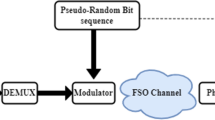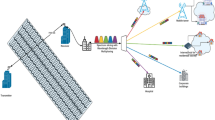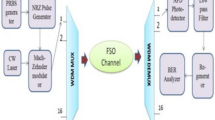Abstract
The free space optical communication system addressed as optical wireless communication has recently received huge attention. Communication acts as the possible way to address the link capacity and spectral efficiency issues. Due to the requirement of fundamental features like higher data rate transmission, improved data security and congestion-free transmission through the atmosphere, effective research interest is aroused in Free space Optic communication systems. As the Free space Optic technology exchanges a technological legacy with optical fibre communication, the Free space Optic links can deliver effective bandwidth. Even though it provides effective link reliability, the disastrous effect is faced due to the accordance of atmospheric attenuations like rain, snow, fog and so on. Hence, to promote effective data transmission, a hybridized model called spectrum slicing–wavelength division multiplexing–polarization division multiplexing (SS–WDM–PDM) is projected in this research work. The major objective of the projected work is to maximize the link capacity and enhance spectral efficiency. The attenuation noises like light rain, heavy rain, medium rain and light fog are considered to evaluate the outcomes of a Free space Optic communication system. The outcomes of the SS–WDM–PDM-FSO system are analyzed for numerous building heights and wind speeds for distance and received power. The parameters like an optical signal-to-noise ratio (OSNR), bit error rate (BER) and Q factor are contemplated to evaluate the performance. The simulation tool adopted to analyze the performance is MATLAB.













Similar content being viewed by others
Data Availability Statement
Data sharing does not apply to this article.
References
Iqbal, S., Raza, A., Butt, M. F. U., Mirza, J., Iqbal, M., Ghafoor, S., & El-Hajjar, M. (2021). Millimeter-wave enabled PAM-4 data transmission over hybrid FSO-MMPOF link for access networks. Optical Review, 28(3), 278–288.
Srivastava, V., & Mandloi, A. (2021). Performance investigation of wavelength diversity based BPSK-SIM FSO system under Gamma-Gamma fading and misalignment error. Optical and Quantum Electronics, 53(11), 1–14.
Sharda, P., Jaiswal, A., Bhatnagar, M. R., Garg, A., & Song, L. (2021). Clustering based diversity improving transmit laser selection schemes using quantized feedback for FSO system. IEEE Transactions on Vehicular Technology, 70(7), 6855–6868.
Bekkali, A., Fujita, H., & Hattori, M. (2021). Fiber-to-fiber FSO system with advanced VCM controlled laser beam pointing and tracking. In 2021 Optical fiber communications conference and exhibition (OFC). IEEE (pp. 1–3).
El-Meadawy, S. A., Shalaby, H. M. H., Ismail, N. A., Farghal, A. E. A., El-Samie, F. E. A., Abd-Elnaby, M., & El-Shafai, W. (2021). Performance analysis of 3D video transmission over deep-learning-based multi-coded N-ary orbital angular momentum FSO system. IEEE Access, 9, 110116–110136.
Shah, S., Siddharth, M., Vishwakarma, N., Swaminathan, R., & Madhukumar, A. S. (2021). Adaptive-combining-based hybrid FSO/RF satellite communication with and without HAPS. IEEE Access, 9, 81492–81511.
Balaji, K. A., & Prabu, K. (2018). Performance evaluation of FSO system using wavelength and time diversity over malaga turbulence channel with pointing errors. Optics Communications, 410, 643–651.
Ibrahim, A. A., & Gucluoglu, T. (2019). Performance analysis of maximum ratio transmission based FSO link over Málaga turbulence channel. Optics Communications, 450, 341–346.
Sandalidis, H. G., Tsiftsis, T. A., Karagiannidis, G. K., & Uysal, M. (2008). BER performance of FSO links over strong atmospheric turbulence channels with pointing errors. IEEE Communications Letters, 12(1), 44–46.
Dhasarathan, V., Singh, M., & Malhotra, J. (2020). Development of high-speed FSO transmission link for the implementation of 5G and Internet of Things. Wireless Networks, 26(4), 2403–2412.
Upadhyay, K. K., Srivastava, S., Shukla, N. K., & Chaudhary, S. (2019). High-speed 120 Gbps AMI-WDM-PDM free space optical transmission system. Journal of Optical Communications, 40(4), 429–433.
Sivakumar, P., Boopathi, C. S., Sumithra, M. G., Singh, M., Malhotra, J., & Grover, A. (2020). Ultra-high capacity long-haul PDM-16-QAM-based WDM-FSO transmission system using coherent detection and digital signal processing. Optical and Quantum Electronics, 52(11), 1–18.
Arora, D., Saini, H. S., Bhatia, V., & Kaur, J. (2022). Enhanced Spectrum slicing: Wavelength division multiplexing approach for mitigating atmospheric attenuation in optical communication. Optical and Quantum Electronics, 54(4), 1–14.
Chaudhary, S., Choudhary, S., Tang, X., & Wei, X. (2020). Empirical evaluation of high-speed cost-effective Ro-FSO system by incorporating OCDMA-PDM scheme under the presence of fog. Journal of Optical Communications. https://doi.org/10.1515/joc-2019-0277
Wang, Z., Shi, W.-x, & Wu, P.-x. (2016). PDM-DPSK-MPPM hybrid modulation for multi-hop free-space optical communication. Optoelectronics Letters, 12(6), 450–454.
Chaudhary, S., Sharma, A., Tang, X., Wei, X., & Sood, P. (2021). A Cost Effective 100 Gbps FSO system under the impact of Fog by incorporating OCDMA-PDM scheme. Wireless Personal Communications, 116(3), 2159–2168.
Jeyaseelan, J., Kumar, D. S., & Caroline, B. E. (2018). PolSK and ASK modulation techniques based BER analysis of WDM-FSO system for under turbulence conditions. Wireless Personal Communications, 103(4), 3221–3237.
Kaur, G., Srivastava, D., Singh, P., & Parasher, Y. (2019). Development of a novel hybrid PDM/OFDM technique for FSO system and its performance analysis. Optics & Laser Technology, 109, 256–262.
Hayal, M. R., Yousif, B. B., & Azim, M. A. (2021). Performance enhancement of DWDM-FSO optical fiber communication systems based on hybrid modulation techniques under atmospheric turbulence channel. In Photonics, Multidisciplinary Digital Publishing Institute, 8(11), 464.
Lee, D., Mai, V. V., & Kim, H. (2021). Mitigation of scintillation in FSOC using RSOA-based spectrum-sliced incoherent light. IEEE Photonics Technology Letters, 33(5), 227–230.
Alshaer, N., Nasr, M. E., & Ismail, T. (2021). Hybrid MPPM-BB84 quantum key distribution over FSO channel considering atmospheric turbulence and pointing errors. IEEE Photonics Journal, 13(6), 1–9.
El-Mottaleb, S. A. A., Métwalli, A., Hassib, M., Alfikky, A. A., Fayed, H. A., & Aly, M. H. (2021). SAC-OCDMA-FSO communication system under different weather conditions: Performance enhancement. Optical and Quantum Electronics, 53(11), 1–18.
Chowdhury, R., & Choyon, A. K. M. S. J. (2021). Design and performance analysis of spectral-efficient hybrid CPDM-CO-OFDM FSO communication system under diverse weather conditions. Journal of Optical Communications. https://doi.org/10.1515/joc-2021-0113
Yaseen, M. A., Abass, A. K., & Abdulsatar, S. M. (2021). Improving of wavelength division multiplexing based on free space optical communication via power comparative system. Wireless Personal Communications, 119(1), 381–391.
Elsayed, E. E., Yousif, B. B., & Singh, M. (2022). Performance enhancement of hybrid fiber wavelength division multiplexing passive optical network FSO systems using M-ary DPPM techniques under interchannel crosstalk and atmospheric turbulence. Optical and Quantum Electronics, 54(2), 1–31.
Choyon, A. K. M. S. J., & Chowdhury, R. (2021). Design of 16× 40 Gbps hybrid PDM-WDM FSO communication system and its performance comparison with the traditional model under diverse weather conditions of Bangladesh. Journal of Optical Communications. https://doi.org/10.1515/joc-2020-0247
Thakur, A., Gupta, A., Singh, H., Bakshi, S., Goyal, R., Singh, G., Mohan, N., & Singhal, A. (2021). Performance evaluation of SS-FSO communication system incorporating different line coding. Optical and Quantum Electronics, 53(6), 1–9.
Thakur, A., Nagpal, S., & Gupta, A. (2018). A performance enhancement and high-speed spectrum sliced free space optical system. Wireless Personal Communications, 100(4), 1775–1789.
Elsayed, E. E., & Yousif, B. B. (2020). Performance enhancement of the average spectral efficiency using an aperture averaging and spatial-coherence diversity based on the modified-PPM modulation for MISO FSO links. Optics Communications, 463, 125463.
Gupta, Y.K., and Goel, A. (2023). Performance analysis of multiple-beam WDM free space laser-communication system using homodyne detection approach. Heliyon.
Funding
No funding is provided for the preparation of manuscript.
Author information
Authors and Affiliations
Contributions
All authors have equal contributions to this work.
Corresponding author
Ethics declarations
Conflict of interest
Authors declare that they have no conflict of interest.
Ethical Approval
This article does not contain any studies with human participants or animals performed by any authors.
Consent to Participate
All authors have agreed to participate in this submitted article.
Consent to Publish
All the authors involved in this manuscript give full consent for publication of this submitted article.
Additional information
Publisher's Note
Springer Nature remains neutral with regard to jurisdictional claims in published maps and institutional affiliations.
Rights and permissions
Springer Nature or its licensor (e.g. a society or other partner) holds exclusive rights to this article under a publishing agreement with the author(s) or other rightsholder(s); author self-archiving of the accepted manuscript version of this article is solely governed by the terms of such publishing agreement and applicable law.
About this article
Cite this article
Vasani, E., Shah, V. An Effective Design of Hybrid Spectrum Slicing WDM–PDM in FSO Communication System Under Different Weather Conditions. Wireless Pers Commun 130, 777–800 (2023). https://doi.org/10.1007/s11277-023-10309-3
Accepted:
Published:
Issue Date:
DOI: https://doi.org/10.1007/s11277-023-10309-3




